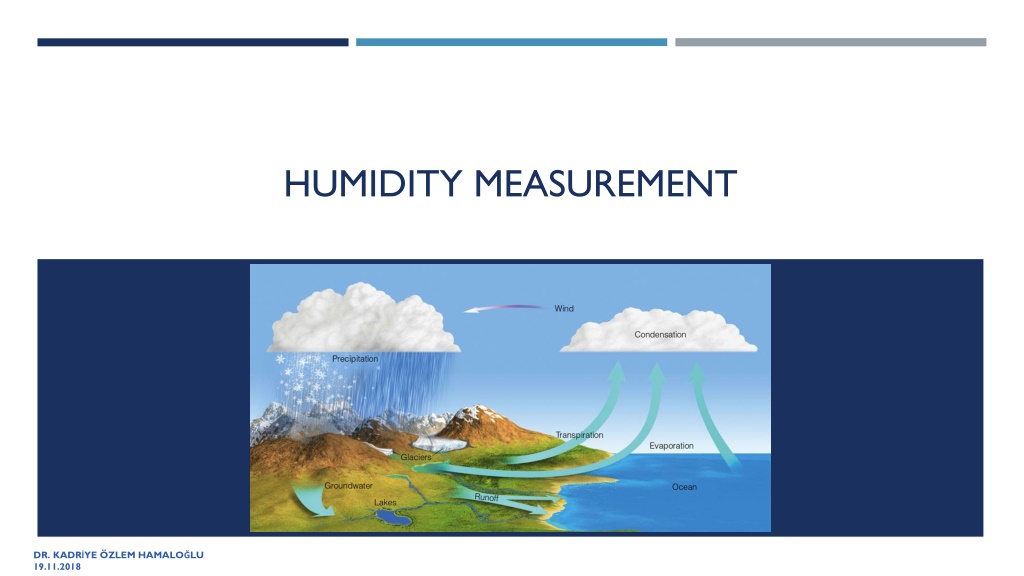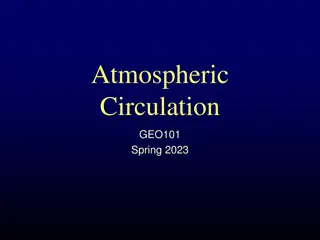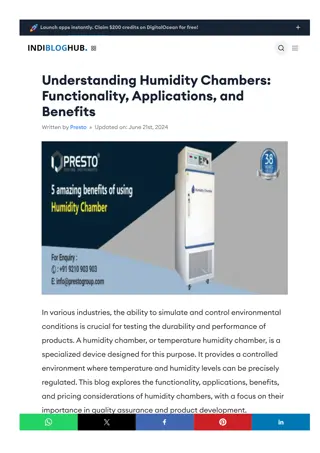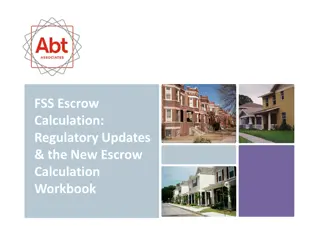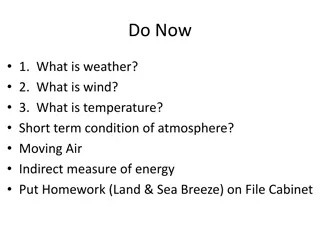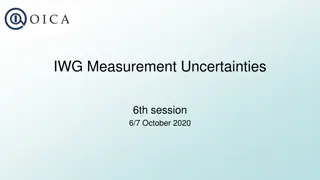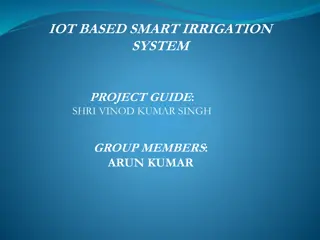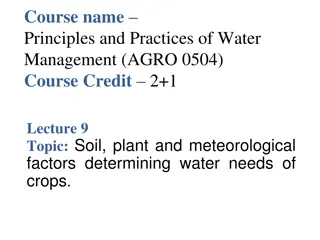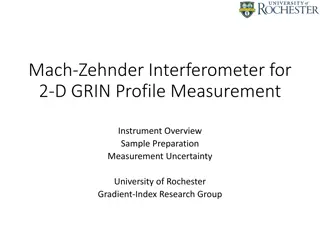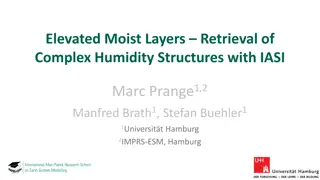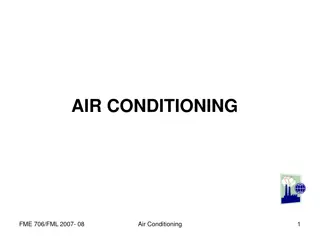Understanding Humidity: Measurement, Classification, and Calculation
Humidity is the amount of water vapor in the air, impacting weather conditions and human comfort. It can be classified as absolute humidity and relative humidity, each playing a crucial role in determining atmospheric moisture levels. The calculation of relative humidity involves comparing the vapor pressure to the equilibrium vapor pressure at a specific temperature. Various humidity sensors are utilized to monitor and measure these important atmospheric conditions.
Uploaded on Sep 29, 2024 | 0 Views
Download Presentation

Please find below an Image/Link to download the presentation.
The content on the website is provided AS IS for your information and personal use only. It may not be sold, licensed, or shared on other websites without obtaining consent from the author. Download presentation by click this link. If you encounter any issues during the download, it is possible that the publisher has removed the file from their server.
E N D
Presentation Transcript
HUMIDITY MEASUREMENT DR. KADR YE ZLEM HAMALO LU 19.11.2018
HUMIDITY Humidity is the amount of water vapor present in the air. Water vapor is the gaseous state of water and is invisible. Humidity indicates the likelihood of precipitation, dew, or fog. Higher humidity reduces the effectiveness of sweating in cooling the body by reducing the rate of evaporation of moisture from the skin. The amount of water vapor that is needed to achieve saturation increases as the temperature increases. DR. KADR YE ZLEM HAMALO LU 19.11.2018
CLASSIFICATION OF HUMIDITY Humidity can be classified into : Absolute Humidity Relative Humidity DR. KADR YE ZLEM HAMALO LU 19.11.2018
ABSOLUTE HUMIDITY Absolute humidity is the total mass of water vapor present in a given volume of air. Absolute humidity is the mass of the water vapor , divided by the volume of the air and water vapor . The absolute humidity changes as air temperature or pressure changes. Absolute humidity in the atmosphere ranges from near zero to roughly 30 grams per cubic meter when the air is saturated at 30 C (86 F). DR. KADR YE ZLEM HAMALO LU 19.11.2018
RELATIVE HUMIDITY Relative humidity (RH) is the ratio of the partial pressure of water vapor to the equilibrium vapor pressure of water at a given temperature. Relative humidity depends on temperature and the pressure of the system of interest. It requires less water vapor to attain high relative humidity at low temperatures; more water vapour is required to attain high relative humidity in warm or hot air. DR. KADR YE ZLEM HAMALO LU 19.11.2018
CALCULATION OF RELATIVE HUMIDITY The relative humidity (RH} of an air water mixture is defined as the ratio of the partial pressure of water vapor (PH20) in the mixture to the equilibrium vapor pressure of water (P* H20) a flat surface of pure water at a given temperature : RH = PH20 / P* H20 Relative humidity is normally expressed as a percentage ; a higher percentage means that the air water mixture is more humid ; a lower percentage means that the air-water mixture is less humid . The relative humidity is the percent of saturation humidity , generally calculated in relation to saturated vapor density. Relative Humidity = Actual Vapor Density / Saturation Vapor Density * 100 % The most common units for vapor density are gm/m3. DR. KADR YE ZLEM HAMALO LU 19.11.2018
HUMIDITY SENSORS DR. KADR YE ZLEM HAMALO LU 19.11.2018
RELATIVE HUMIDITY SENSORS Relative humidity sensors are classified into ceramic, semiconductor, humidity sensors. and polymer Ceramic Sensing Material Humidity sensors based on water-phase protonic ceramic materials are used widely in industry and research laboratories. The adsorbed water condensed on the surface of the materials and protons will be conducted in the formed aquatic layers. For ionic sensing materials, if the humidity increases, the conductivity decreases and the dielectric constant increases. DR. KADR YE ZLEM HAMALO LU 19.11.2018
HYGROMETER A hygrometer is an instrument used for measuring the moisture content in the atmosphere. Humidity measurement instruments usually rely on measurements of some other quantity such as temperature, pressure, mass or a mechanical or electrical change in a substance as moisture is absorbed. By calibration and calculation, these measured quantities can lead to a measurement of humidity. Modern electronic devices use temperature of condensation (the dew point), or changes in electrical capacitance or resistance to measure humidity differences. Due to humidity, several materials experience a change in physical, chemical and electrical properties. This property is used in transducer that are designed and calibrated to read relative humidity directly. DR. KADR YE ZLEM HAMALO LU 19.11.2018
TYPES OF HYGROMETERS Classical Hygrometer's 1. Metal-paper coil type 2. Hair tension hygrometer 3. Pyschrometer (wet and dry bulb hygrometer ) : Sling pyschrometer 4. Chilled mirror dew point hygrometer Modern Hygrometer's 1. Capacitive 2. Resistive 3. Thermal 4. Gravimetric DR. KADR YE ZLEM HAMALO LU 19.11.2018
HAIR HYGROMETER Hair hygrometer is a type of absorption hydrometer and uses the mechanical humidity sensing technique. Certain hygroscopic materials such as human hair, animal membranes, wood, paper, etc., undergo changes in linear dimensions when they absorb moisture from their surrounding air. This change in linear dimension is used as the measurement of humidity present in air. DR. KADR YE ZLEM HAMALO LU 19.11.2018
HAIR HYGROMETER Human hair is used as the humidity sensor. The hair is arranged in parallel beam and they are separated from one another to expose them to the surrounding air/atmosphere. Number of hairs are placed in parallel to increase mechanical strength. This hair arrangement is placed under small tension by the use of a tension spring to ensure proper functioning. The hair arrangement is connected to an arm and a link arrangement and the link is attached to a pointer pivoted at one end. The pointer sweeps over a humidity calibrated scale. Human hair has a property that its length increases when it is wet and its length decreases when it goes dry . DR. KADR YE ZLEM HAMALO LU 19.11.2018
APPLICATIONS & DISADVANTAGES APPLICATIONS These hydrometers are used in the temperature range of 0 C to 75 C. These hydrometers are used in the RH (Relative Humidity) range of 30 to 95%. DISADVANTAGES These Hydrometers are slow in response . If the Hair hydrometer is used constantly, its calibration tends to change. DR. KADR YE ZLEM HAMALO LU 19.11.2018
WET & DRY BULB HYGROMETER A pyschrometer or wet & dry bulb thermometer , consist of two thermometers, one that is kept moist with distilled water on a sock or wick. At temperatures above freezing point of water, evaporation of water from the wick lowers temperature so that the wet-bulb usually shows a lower temperature than that of the dry-bulb thermometer. When the air temperature is below freezing , however the wet-bulb is covered with a thin coating of ice and may be warmer than the dry bulb . Dry-Bulb temperature (DBT): The dry-bulb temperature is the temperature indicated by a thermometer exposed to the air in a placed sheltered from direct solar radiation . The term dry-bulb is customarily added to the temperature to distinguish it from wet-bulb and dew-point temperature. Wet-Bulb thermodynamic property of mixture of air and water vapor . The value indicated by a wet-bulb thermometer approximation of the thermo-dynamic wet-bulb temperature . temperature (WBT):The thermodynamic wet-bulb is a often provides an adequate DR. KADR YE ZLEM HAMALO LU 19.11.2018
SLING PYSCHROMETER A sling psychrometer, which uses thermometers attached to a handle or length of rope and spun in the air for about one minute, is sometimes used for field measurements, but is being replaced by more convenient electronic sensors. A whirling psychrometer uses the same principle, but the two thermometers are fitted into a device that resembles a ratchet or football rattle. DR. KADR YE ZLEM HAMALO LU 19.11.2018
APPLICATIONS & DISADVANTAGES APPLICATIONS It is used for checking humidity level in airconditioned rooms and installations. It is used to set and check hair hygrometer. It is used in the measurement range of 0 to 100% RH. It is used for measuring wet bulb temperature between 0 C to 180 C. DISADVANTAGES The measured medium is disturbed due to the act of measurement. The evaporation process at the wet bulb will add moisture to the air. It cannot be used in automation requirement situations. It cannot be used for continuous recording purpose. If the wick is covered with dirt, the wick will become stiff and its water absorbing capacity will reduce, however, a stiff/dirty wick will resume normalcy when boiled in hot water. DR. KADR YE ZLEM HAMALO LU 19.11.2018
CHILLED MIRROR OPTICAL SENSOR Chilled Mirror Dew Point Mirror is chilled until dew is formed. The temperature at which saturation is achieved is determined by observing condensation on a chilled surface (mirror). Advantages Very high accuracy & High reliability. Disadvantages Need clean mirror & More expensive. DR. KADR YE ZLEM HAMALO LU 19.11.2018
CAPACITIVE RELATIVE HUMIDITY SENSORS Capacitance increases in value as water molecules are absorbed into its active polymer dielectric. The change in capacitance is typically 0.2 0.5 pF for a 1% RH change. Capacitive sensors are characterized by low temperature coefficient, ability to function at high temperatures (up to 200 C), full recovery from resistance to chemical vapors. condensation, and reasonable The response time ranges from 30 to 60 s for a 63% RH step change. The typical uncertainty of capacitive sensors is 2% RH from 5% to 95% RH with two-point calibration. DR. KADR YE ZLEM HAMALO LU 19.11.2018
RESISTIVE HUMIDITY SENSORS Resistive humidity sensors measure the change in electrical impedance of a hygroscopic medium such as a conductive polymer, salt, or treated substrate. The impedance range of typical resistive elements varies from 1 k to 100 M . The response time for most resistive sensors ranges from 10 to 30 s for a 63% step change. A distinct advantage of resistive RH sensors is their interchangeability, usually within 2% RH, which allows the electronic signal conditioning circuitry to be calibrated by a resistor at a fixed RH point. This eliminates the need for humidity calibration standards, so resistive humidity sensors are generally field replaceable. DR. KADR YE ZLEM HAMALO LU 19.11.2018
THERMAL CONDUCTIVE ABSOLUTE HUMIDITY Measures absolute humidity When air or gas is dry, it has a greater capacity to sink heat. Gets reference value from a thermistor sealed in dry air. Can withstand temperatures >200 F DR. KADR YE ZLEM HAMALO LU 19.11.2018
ELECTRICAL RH SENSORS Capacitance changes with RH Thin layer of hygroscopic polymer between two capacitance plates ~2% accuracy to 90% RH, then ~3% DR. KADR YE ZLEM HAMALO LU 19.11.2018
ELECTRICAL RH SENSORS Resistance changes with RH. Less accurate Responds decreasing RH differently to increasing versus Also a thermistor in this RH/Temperature sensor DR. KADR YE ZLEM HAMALO LU 19.11.2018
RADIATION ABSORPTION HYGROMETERS DR. KADR YE ZLEM HAMALO LU 19.11.2018
PSYCHROMETRIC CHART DR. KADR YE ZLEM HAMALO LU 19.11.2018
